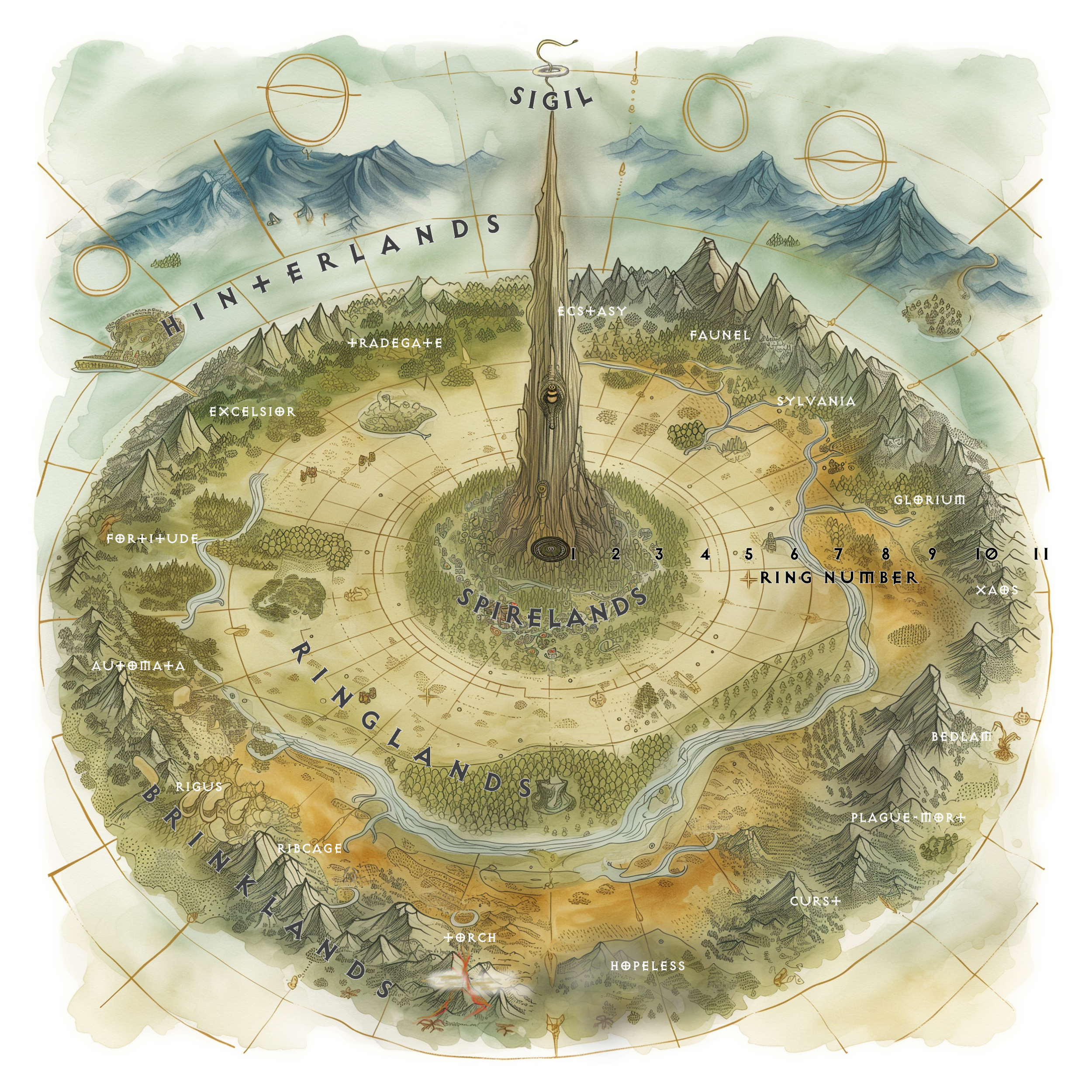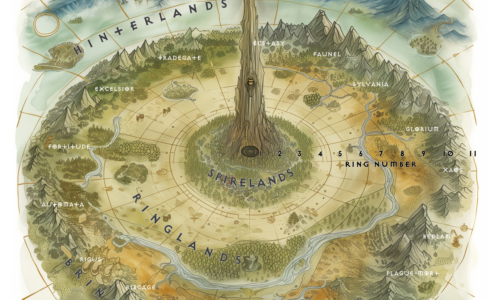[ Outlands ] [ Spirelands | Ringlands | Gate-Towns | Hinterlands | Splinterlands | Underlands ]
Magic and the Spire

Every basher who walks the Outlands knows that the Spire has a neutralising effect on magic, even the magic of the powers. As you get closer to the Spire, magic is more and more nullified, until in the foothills of the Spire, a god has no more supernatural power than a mortal. A cutter would be wise to track the change in the magical weave, lest items they carry, or spells they cast fizzle out. Temporarily, of course; your magic sword might stop working as expected near the Spire but you can still hit a berk with the sharp bit, and its magic will return when you move back out. And of course, creatures you can only harm with magical weapons also lose that protection the same time your sword dies out, so there’s a weird kind of balance there too cutter.
Chant goes there’s a ring of ruins surrounding the Spire where careless wizards learned an expensive lesson: Owners of walking castles beware; many’s the berk whose fancy mobile home ground to a halt when they crossed over too close to the Spire, the magic weave forsook them, and the walking castle very quickly became a falling castle. Good luck getting that one started up again.
There ain’t no markings or signposts to show where the magic flux changes, in fact they say the boundaries move in and out like they’re breathing. A basher with the ability to detect magic can spot where the auras shift easily enough. Until they reach the Spire itself of course, when even simple cantrips fizzle out.
There are persistent rumours that the rilmani are actually able to use some kind of magic at the Spire. Whether this chant is true, or just screed, isn’t clear. This author suggests being very careful not to annoy any rilmani on their home ground.
| Ring Number | Area | Effect on Magic | Effect on Physics |
| 12 | The Splinterlands | All magic functions normally | Everything is strange here, DMs encouraged to have fun with unexpected effects, see the Splinterlands page for more details |
| 11 | The Hinterlands | All magic functions normally | Distances work strangely; see the Hinterlands page for more details |
| 10 | The Brinklands, including the Gate-Towns | 10th level spells fail* | |
| 9 | The Ringlands | 9th level spells (and equivalent spell-like abilities) fail | |
| 8 | The Ringlands | 8th level spells fail | |
| 7 | The Ringlands | 7th level spells fail | |
| 6 | The Ringlands | 6th level spells fail; magical walking castles grounded | Negative energy draining ceases to function |
| 5 | The Ringlands | 5th level spells fail; +5 magic items become +4* | Poisons no longer function |
| 4 | The Spirelands | 4th level spells fail; demipowers lose their abilities; +4 items become +3* | Planar conduits fail; planar pathways not found beyond this ring |
| 3 | The Spirelands | 3rd level spells fail; lesser powers lose their abilities; +3 items become +2 | Astral connections impossible; portals no longer found—you have to walk from here, cutters! |
| 2 | The Spirelands | 2nd level spells fail; intermediate powers lose their abilities; +2 items become +1 | |
| 1 | The Spire | 1st level magic and cantrips fail; all magic items lose their abilities; even greater powers are rendered powerless |
Source: Jon Winter-Holt, mimir.net. Canonwatch: I’ve taken the 1e AD&D and 2e Planescape magic tables and modified a few things slightly. In the original rules psionics just cut out at the 6th ring—the Planescape writers were self-confessedly not fans of psionics! Pathfinder psychics use spells anyway, so that’s easy enough to convert. I do not pretend to understand what 5e D&D has done with psionics so have fun working that out depending on if/how you implement them! My suggestion would be to phase them out at a similar rate to magic so that at the Spire, everyone is equal. Regarding the rilmani, in 2e Planescape there was no mention of them using magic at the Spire, but the 5e books suggest they can. Use whichever rules work for you!
* Assuming they exist in your chosen game rules (looking at you, D&D 5e and PF 2e)



Labeling the rings this way is confusing. I think it’s better to keep the labels used in Sigil and Beyond (in the chart, not the text!) where the Spirel is 0 and the 1st ring is where 1st level magic is possible. Then your chart would correspond to the one in 2e.
My other suggestion is that for Epic play, you can keep track of rings further into the Hinterlands, with each allowing another level of Epic magic to work, as well as being magically morphic for non-aligned spells.
What do you think of the way the rings work in 3e? The Manual of the Planes changed where the Astral connections and poisons poop out.
This is a good point. I will need to amend some graphics but yep, makes sense to try and align it better with the way the PS 2e books put it. Thanks!
In 5E, weapons and armor can only go up to a +3 bonus. Would the comments about +4 and +5 just be ignored?
Thanks.
Ah yes, I didn’t realise 5e also did away with those, like Pathfinder 2. Yes, I would just ignore those comments.
What does “Entropy ceases altogether” mean?
I got that idea from the 1e Manual of the Planes, which states that 100 miles from the Spire (although there it’s called the Center), all chemical reactions, burning, dissolving etc cease and neither man nor god can come closer to the centre. I dropped the second sentence as clearly the rilmani can. I swapped chemistry for entropy but maybe I should make it more vague. Or perhaps discuss the differences in the different editions (as well as coming up with a workable compromise between them!) What would you like to see?
I definitly remember a few mentions of mortals climbing the Spire, and I think it’s a cooler visual than an everyone-dies zone (not to mention that one vertical rilmani city on the Spire). Plus, I think that having a place that basically kills you by freezing time without any workaround (due to antimagic) can be a bit world-breaking.
Honestly, in my personal interpretation Spirelands are supposed to be the metaphysical representation of what we think of as the “normal world”, so I would drop the ceasing entropy thing altogether. Although… maybe you could say that some supernatural properties turn off near the Spire. For example, dragons can’t fly and breathe fire, devils become as vulnerable to fire as other creatures, elementals turn into inanimate piles (on the fence about this one) and so on. Everyone becomes a glorified animal or robot. But that will very likely to be almost unapplicable in the real game because of how arbitrary defining “supernatural” can be
this is canon lore–also, the lady of pain is not one to be underestimated.
I actually thought a lot about this and was looking for some middle ground that I can use in my campaign.
In the older DnD editions the ‘Dead Magic Zone’ around the Spine was a central part of the canon, in 5e this was replaced by a small entry that ‘magic-free areas occur around the Spine’.
I don’t agree with this
My rule :
– The Spine itself is a magic aggravating zone. Magic works, but EVERY magic (no matter if cantrip or 9-lvl spell) needs a concentration saving throw (Con save) to be cast.
– If a player has to make an additional concentration roll due to an external effect (e.g. damage), this is always at a disadvantage
– Outside the Spine ( radiating into the Outlands ) is a ring-shaped zone in which this effect diminishes. This zone is changeable and variable in its extent, but can be roughly divided into ring-shaped areas, each about a day’s travel deep. The closer to the spine the more magic is restricted, the further out the less.
– Magic items may lose their power. This effect is (usually) only temporary, but is not always predictable. It is often first noticed when items that are attuned tend to unbind.
– Sigil itself is an exception. Here magic works normally, but is limited for certain effects and spells ( teleportation, summoning )
I also linked up this page in my Discord for the players to use, and am increasingly using Mimir descriptions as references in my Campaign 😉